It was Pico Iyer who made me long to visit Lamayuru. In his enchanting travel story on Ladakh in New York Times, he describes the approach to Lamayuru and its mountains with extra vigour.
“… along a zigzagging, one-lane road that winds up and up above a sheer drop, I recalled at every heart-stopping turn why the word “gompa” means “solitary place,” until suddenly, as we rounded a corner, Lamayuru Gompa was there before us, high up on a cliff.
…I had thought myself hard to impress after traveling for decades across the Himalayas, I heard a gasp escape my jaded lips, and realized I was glimpsing a location even more unlikely than that of the Potala Palace in Lhasa, and a temple even older than that wonder of the world.”

I put Lamayuru high on the list during my first visit to Ladakh, but did not expect the journey to become an adventure. The day before I was to travel from Leh to Lamayuru, clouds had taken over the sky all over Ladakh. Heavy rains through the night had fueled angry streams that poured truck loads of mud on the roads and broke bridges that they flowed under. The next morning, an hour’s journey from Leh, we were stopped by a landslide – a slushy mass of mud under which the road had disappeared.
That, however, wasn’t something to worry about. Clearing the road was a ten-minute job for the BRO earth movers, though the powerful machines took more than an hour to arrive at the location. The real trouble awaited us only a kilometer ahead, where a roaring stream had taken away an iron bridge that came on its way. Unlike our last obstacle, this one wasn’t going to be put back in shape in ten minutes. We had to find another way out.
As we waited and the day progressed, vehicles kept piling up on either side of the road. Some villagers built a temporary walking bridge by laying poplar stems across a narrow crossing. Buses arriving on either side struck deals to exchange passengers. It took a few hours of waiting, but eventually we were on our way.
On reaching Lamayuru a few hours later, I realized that the landslide had worked to our advantage. The day before our arrival, every guesthouse in the village was running full and a few people even had to sleep on the veranda of the houses or floors of restaurants. But thanks to the closed roads, taxis weren’t plying today and the tourist crowd had stayed off. Guesthouses were going empty.
The prize for arriving at Lamayuru was a view found nowhere else in Ladakh. The mountain slopes below the village once supported a now-drained-off gigantic lake. The slopes that were once under water appeared like a big splash of yellow butter over the otherwise dark-brown mountains that rise steeply from the base of the valley. Often called ‘moonland’ by the locals, these gently undulating mass of hardened mud was supporting a glacial water body that existed millenniums ago. With the passage of time, erosion from wind and water had created curious patterns all over the slopes – some like bastions of castles rising above the steep cliffs, some like smooth sea of sand dunes and some that looked like massive cheese blocks with many holes in them.
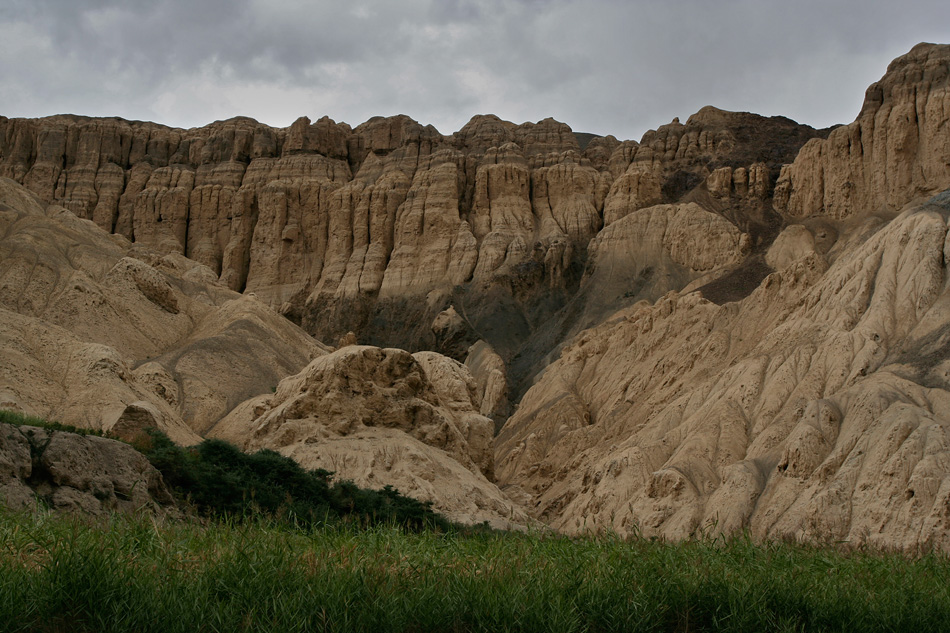
Standing high above these magical slopes was the monastery of Lamayuru built over the mud-castles created by nature. The monastery’s construction crept into the crevices under its foundation, with its doors and windows making surprise appearances to break the contiguity in the slopes holding them. A bunch of chortens stood high above the monastery, making an effort to stretch a little higher the already-high mountains that reached for the clouds.
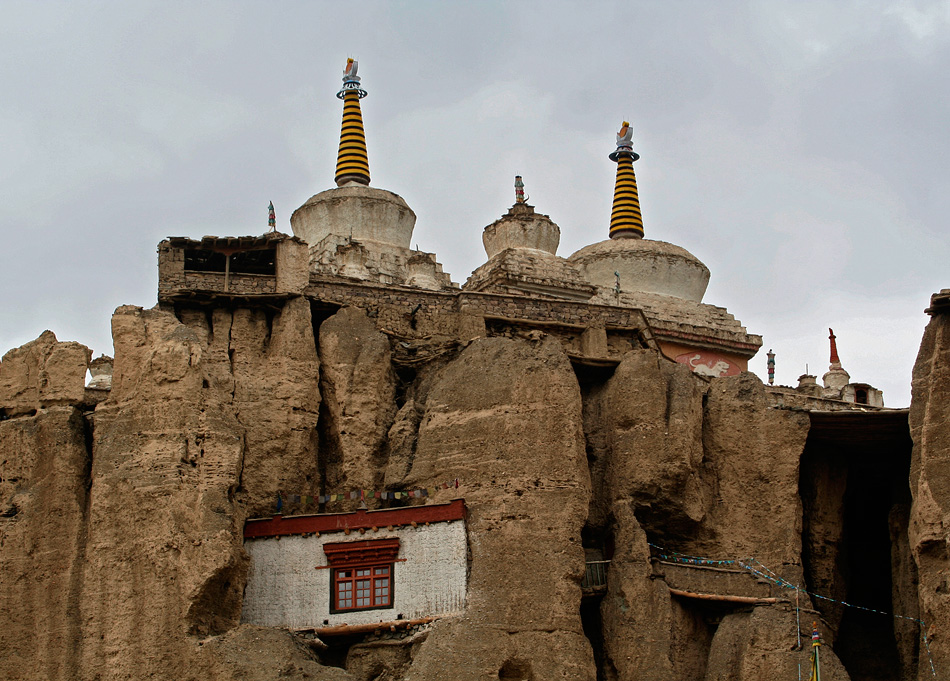
The monastery’s past is a mix of history and legends. It is one of the oldest Buddhist Monasteries in the region, built in eleventh century by monk Rinchen Zangpo who was known for his translation of Buddhist texts from Sanskrit to Tibetan. The monastery was a witness to several confrontations between the armies of Ladakh with those of Kashmir and Central Asia, with fortunes swinging in different ways through 13th century to 15th century. The monastery had to be rebuilt again after it was completely destroyed by the army of King Zorawar Singh in early 19th century. When Central Asian armies retreated from Lamayuru after facing natural calamities created by protective forces, the place was declared a sanctuary for criminals, who were deemed free of their acts after entering the boundary of the monastery.
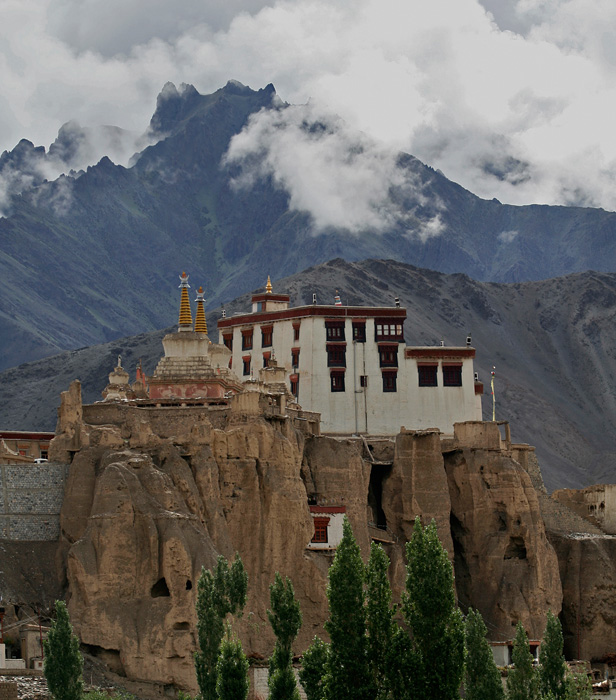
I spent my days in Lamayuru walking up and down the slopes that offered me many perspectives of the ‘moonland’. The roads, usually empty but now completely silent thanks to the broken bridge, allowed us to walk in peace without the occasional noises that broke the peace in the mountains. The clouds that had threatened our arrival at Lamayuru continued to hover over the mountains, but did not create further trouble. Two days later, when the news came that a new bridge was now ready in place of the broken one, it was time for me to return before a new wave of visitors would hit Lamayuru.
Also see: Our photography tour to Ladakh in winter.
The pilot aligned the aircraft along the east-west direction of the Indus Valley before he reduced altitude. The aircraft gently zig-zagged in the sky, tracing the path of the azure river at the valley floor. With 6000 meter-high mountains rising steeply on either sides, the only way to descend into Leh was through the long-running trough of Indus River. From up in the sky, we followed the path of the river for a few minutes. When we had descended well below the altitude of the peaks that dominated the landscape, a steep U-turn at the widest part of the valley allowed us to make the final descent. We had arrived in Leh.
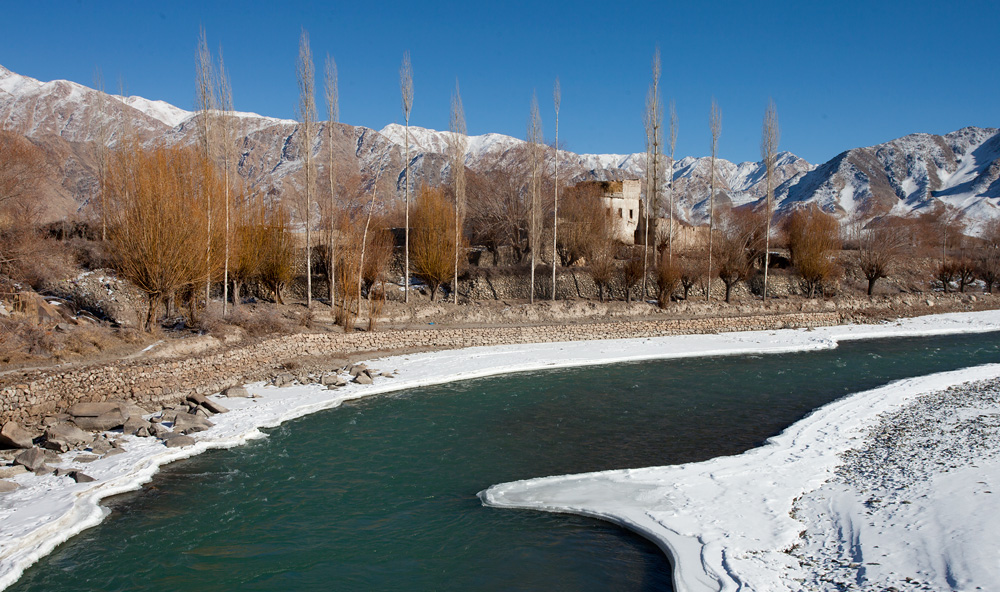
We taxied out of the runaway as the cabin crew made the usual announcements. For some reason, they decided not to mention the outside temperature, perhaps with a goodwill to let us stay comfortably in the warmth of the aircraft without worrying about the harsh weather that awaited us. It must have been anywhere between five to ten degrees below zero that morning, a comfortable day by local standards in winter.
A wave of cold pricked my face as soon as I stepped out of the aircraft. I was well protected with multiple layers of warm clothes that covered much of my body – good enough to help me survive the cold but never enough to make me feel cozy. Airline staff rushed us to the awaiting bus, asking us not to stay out for long. The bus, quickly filled up with passengers, took us to the terminal with much needed central heating. Out from the airport, it was again a short hop exposed to the cold before we were whisked away to our guesthouse in a waiting vehicle. It was a similar story on reaching the guesthouse, where we quickly got off the car and rushed into the warm interiors.
This was my fourth visit to Ladakh in as many years and a second one in winter months. Although temperatures never rose above the freezing point, it was warm compared to my last visit in the same season. The mountains weren’t as thickly covered in ice as they were during my previous visit. There wasn’t any snow to be seen on the roads.
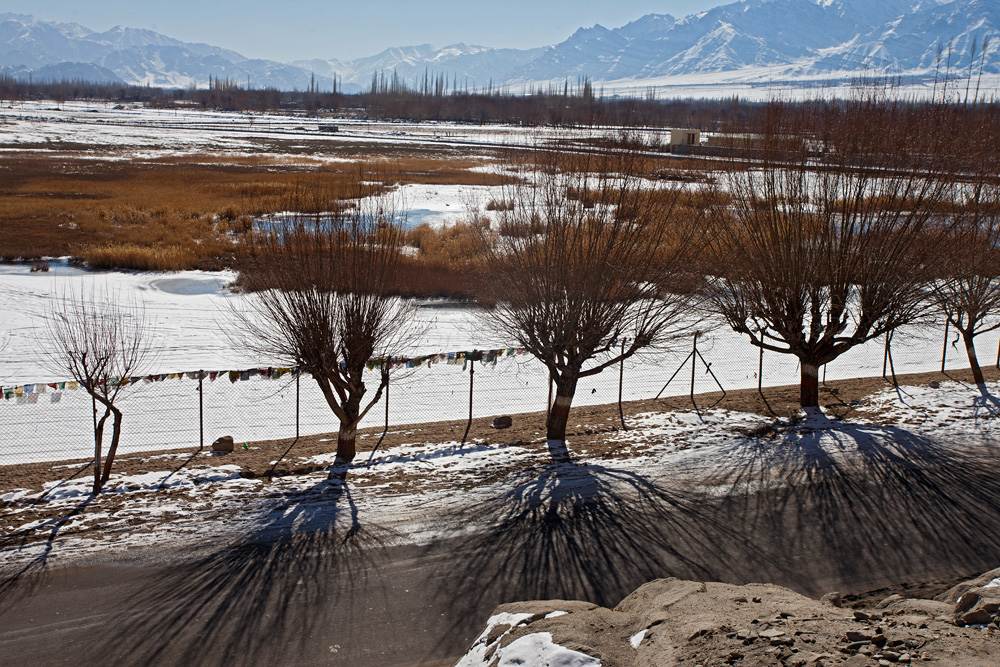
Compared to summer months, there were a few more things missing from the roads of Leh – vehicles and people. Falling mercury with the approach of winter had also brought a fall in tourist numbers. The shops selling curios, restaurants dishing out pizzas or Korean food, hotels of all sizes that dominate the landscape of Leh, the line of pigeon-hole enterprises with signs that announce “jeep safari, trekking,..” had all shut down until the next summer. Taxis that ferry the tourists had gone off the road. I peeked through a small enclosure with a sign that said ‘painteball arena’, only to see some clothes drying on a lane tied to poplar trees. ‘For six cold months, the busy tourist town goes silent. The few private vehicles occasionally seen on the roads belonged to the locals. The shops that stayed open catered to the residents and so did restaurants.
At ‘Friend’s Corner’, the most popular winter-time restaurant in the town, I saw only mongoloid-faced Ladakhis relishing on Thukpas and Chowmein. My host for the day’s lunch was Tundup, who runs a travel agency in Leh. He was spending his days mostly relaxed, but for some occasional planning for the upcoming summer rush. For the people of Ladakh, winter is a season for rest, festivities and merry making. The harsh winter weather doesn’t deter them; they are used to it.
A transition from summer to winter was also apparent in the landscape of Leh. The fields and gardens, which the people of the town and surrounding villages lovingly tend to, now stood brown and unattended. Poplar and willow trees had lost all their leaves. But the usually barren mountains had now come alive with a charming sprinkle of snow on their slopes.
It is this snow in the mountains and much larger deposits of it in the remote regions that has attracted me to Leh in winter. Two years ago, I had my first encounter with Ladakh’s winter over an expedition on the frozen Zanskar River, commonly called Chadar Trek. While I discovered how brutal the weather can get, I also fell in love in the snowy landscapes. I had now come back for more, to visit the frozen Pangong Lake and to drive on the snowfields that the eastern Changthang Plateau morphs into (more on these in another post).
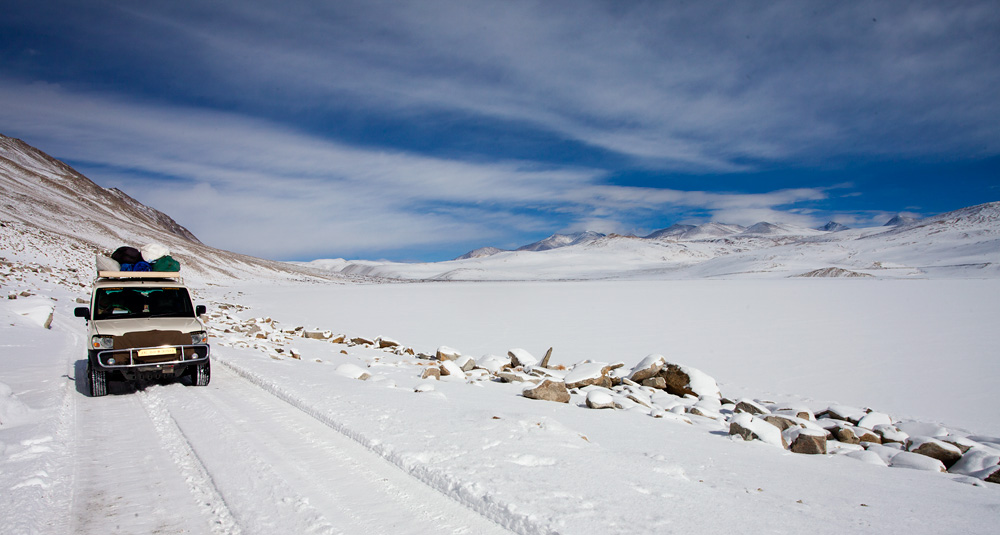
Roads filled with snow in Ladakh
So how is it, being in Leh in winter? It is a time of the year when you can’t take many things for granted, which you could have during a summer visit. It is important to plan for clothing elaborately, or you would find it hard even to get out of the airport. Most of the hotels remain closed, so it is essential to identify one that remain open, and book in advance. Those few that remain open necessarily offer heating, but almost no one will offer running water in the bathrooms (water freezes in the pipes). Only a handful of restaurants remain open in the main market, and finding one for dinner is not only a painful affair in the cold of the night, there will be even fewer that remain open compared to lunch time. Dinners almost always have to be at your hotel or guesthouse.
The roads in Ladakh, however, continue to stay open despite the harsh weather. Occasionally, snowbound high passes may be shutdown for a few days, but the Border Roads Organization works continuously to keep them open for vehicles. Visits to Pangong Lake (where temperatures dip to 30 below zero), Nubra Valley and Tso Moriri Lake continue to remain accessible.
The monasteries across Ladakh will also remain open, though most of the monks will be away and the activities will be reduced to a minimum. At Stakna Monastery, the only person we met was the caretaker-monk who was on duty , who opened the doors of the dukhang (prayer hall) for us. We moved quickly from prayer hall to the next temple and the next, unable to stand barefoot on a floor that seemed determined to freeze us. Outside the monastery, where it had just begun snowing, the village stood desolate as its people remained confined to the houses. Across the village, a deep blue Indus flowed gently, partially frozen on either sides.
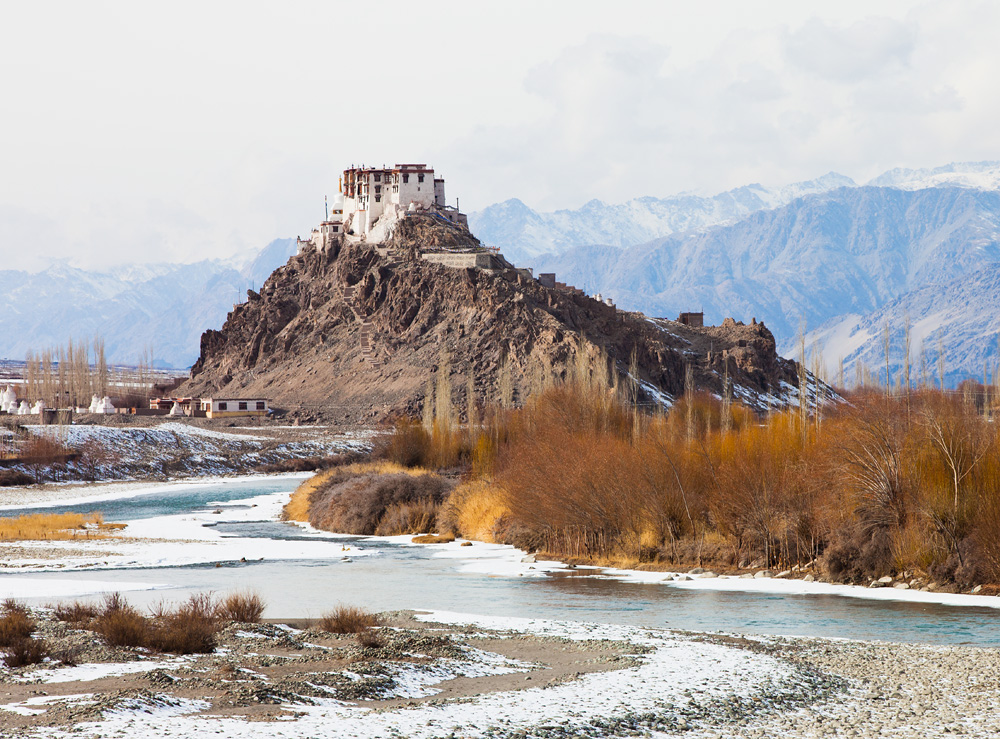
Indus River and Stakna Monastery
It was a similar story in Thiksey, where we were greeted to a near-empty monastery. As in Stakna, the only person we saw was the caretaker-monk. But in nearby Shey Village, it was a festival day with large gathering of people waiting to be blessed by the monks. We saw a congregation of a few thousands dressed at their best, patiently waiting for the activities to begin. Outside the monastery, many vendors had gathered, selling stuff as varied as ‘garam garam momos’, sun-dried apricots, ready-to-wear clothing and raw sheep wool.
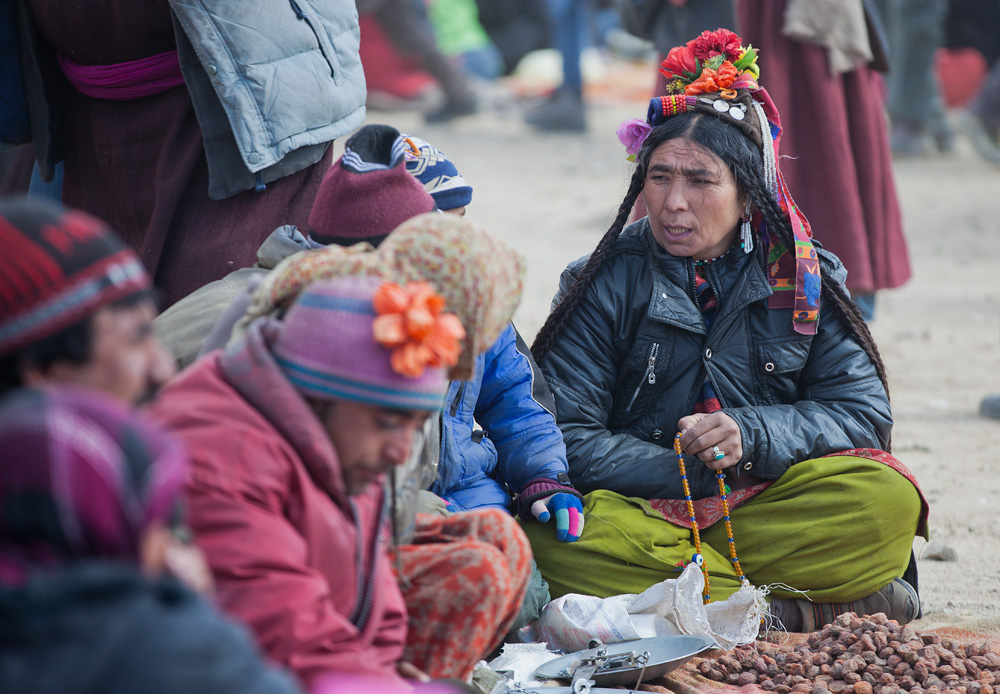
I bought some sun-dried apricots later in the day at Leh’s now quiet main-market. They tasted good, but were no match to the juicy apricots that you can simply pluck from a tree and relish during the summer days. There are many such pleasures that you can’t find in the winter months in Ladakh. Visitors have to endure the cold and live without the luxuries of summer. But the landscapes–snow-covered slopes, half-frozen rivers, fully frozen lakes, earth that looks like ice fields–are a splendid work of nature that can only be witnessed in this season.
Bridges had fallen and the roads were cut off. A long line of waited for many hours hoping for things to get better. Buses were cancelled and they had no clear answers to when the services will resume. “It depends on the weather, sir,” was the fence-sitting answer from the person manning the phone at the bus company, who neither had any real-time information nor had powers to provide decisive answers.
Himachal Pradesh was seeing heavy rains in the past few days. As it happens every year, landslides had crippled the road infrastructure and there was a cloud of uncertainty over what happens next. Unpredictable as the weather here is, things might magically settle back to normal next morning. Or it could very well turn worse if another line of dark clouds made their way towards the mountains.
My local contact constantly kept me updated on all the information he was able to procure. He had someone or the other in every part of Himachal giving him updates. Yet, nothing seemed certain. I turned to Twitter, looking for all the latest information that one could ask for. I had become like a journalist with a undying fetish for breaking news, scouring for every information that I could get, so that I can make informed decision on our next move.

Chandratal. This is where we were headed before the weather gods made us change plans.
The road from Delhi to Manali was affected by incessant rains that had brought down a bridge at someplace 100km before Manali. Himachal Parivahan had cancelled the night’s bus, since the bus that had left the previous evening from Delhi had not reached Manali yet. Nor did the buses from Manali make it to Delhi. We were stranded in Delhi for a night and were struggling to know the current status, so that we know what to do on the next day. My logistics organizer insisted that we rent a car and just head out, as someone would be working at the bridge and everything would be fine by the time we make the ten hour journey to the point-of-problem.









